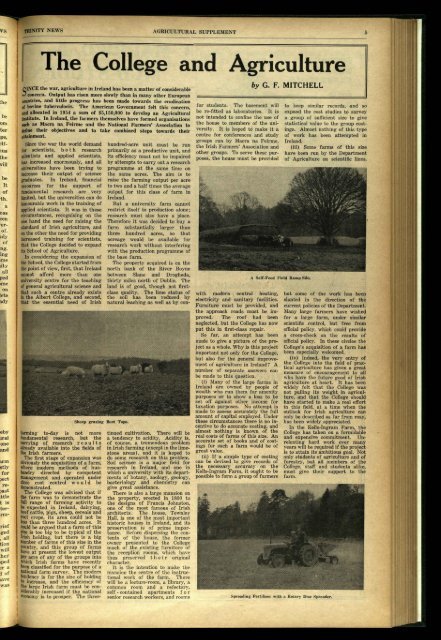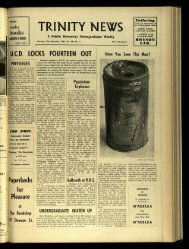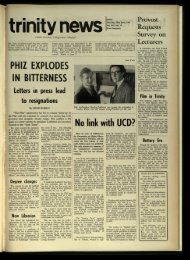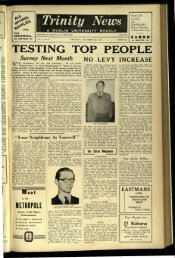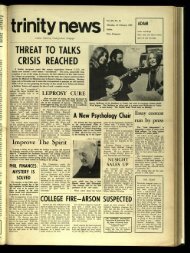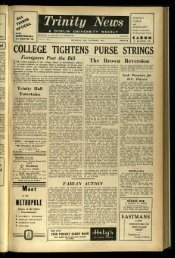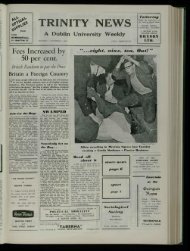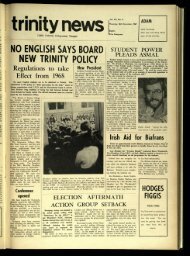MacBRIDE SPEAKS - Trinity News Archive
MacBRIDE SPEAKS - Trinity News Archive
MacBRIDE SPEAKS - Trinity News Archive
Create successful ePaper yourself
Turn your PDF publications into a flip-book with our unique Google optimized e-Paper software.
NEWS AGRICULTURAL SUPPLEMENT 5The College and Agriculture~INCE the war, agriculture in Ireland has been a matter of considerable-. concern. Output has risen more slowly than in many other Europeant0untries, and little progress has been made towards the eradicationof bovine tuberculosis. The American Government felt this concern,and allocated in 1954 a sum of $5,150,000 to develop an AgriculturalInstitute. In Ireland, the farmers themselves have formed organisationssuch as Macra na Feirme and the National Farmers’ Association todefine their objectives and to take combined steps towards theirattainment.Since the war the world demandfor scientists, b o t h researchscientists and applied scientists,has increased enormously, and alluniversities have been trying toincrease their output of sciencegraduates. In Ireland, financialresources for the support offundamental research are verylimited, but the universities can dohonourable work in the training ofapplied scientists. It was in thesecircumstances, recognising on theone hand the need for raising thestandard of Irish agriculture, andon the other the need for providingincreased training for scientists,that the College decided to expandits School of Agriculture.In considering the expansion ofthe School, the College started fromthe point of view, first, that Irelandcannot afford more than oneuniversity centre for the teachingof general agricultural science andthat such a centre already existsin the Albert College, and second,that the essential need of IrishSheep grazingfarming to-day is not morefundamental research, but thecarrying of research resultsalready available into the fields ofthe Irish farmers.The first stage of expansion wasobviously the acquisition of a farm,where modern methods of husbandrydirected by competentl lanagement and operated under(lose cost control would bedemonstrated.The College was advised that ifthe farm was to demonstrate thefull range of farming activity tobe expected in Ireland, dairying,beef cattle, pigs, sheep, cereals androot crops, its area could not beless than three hundred acres. Itcould be argued that a farm of thissize is too big to be typical of theIrish holding, but there is a bignumber of farms of this size in theCountry, and this group of farmshave at present the lowest outputPer acre of any of the groups intowhich Irish farms have recentlybeen classified for the purpose of anational farm survey. The moderntendency is for the size of holdingto increase, and the efficiency ofthe large Irish farm must be con-~iderably increased if the nationaleCOnomy is to prosper. The three-hundred-acre unit must be runprimarily as a productive unit, andits efficiency must not be impairedby attempts to carry out a researchprogramme at the same time onthe same acres. The aim is toraise the farming output per acreto two and a half times the averageoutput for this class of farm inIreland.But a university farm cannotrestrict itself to production alone;research must also have a place.Therefore it was decided to buy afarm substantially larger thanthree hundred acres, so thatacreage would be available forresearch work without interferingwith the production programme ofthe base farm.The property acquired is on thenorth bank of the River Boynebetween Slane and Drogheda,thirty miles north of Dublin. Theland is of good, though not firstclassquality. The lime status ofthe soil has been reduced bynatural leaching as well as by con-Beet Tops.tinued cultivation. There will bea tendency to acidity. Acidity is,of course, a tremendous problemin Irish farming (except in the limestoneareas), and it is hoped todo some research on this problem.Soil science is a major field forresearch in Ireland, and one inwhich a university with its departmentsof botany, zoology, geology,bacteriology and chemistry cangive great assistance.There is also a large mansion onthe property, ’erected in 1800 tothe designs of Francis Johnston,one of the most famous of Irisharchitects. The house, TownleyHall, is one of the most importanthistoric houses in Ireland, and itspreservation is of prime importance.Before dispersing the contentsof the ~house, the formerowner presented to the Collegemuch of the existing furniture ofthe reception rooms, which havethus preserved t heir originalcharacter.It is the intention to make themansion the centre of the instructionalwork of the farm. Therewill be a lecture-room, a library, acommon room and a refectory,self - contained apartments f o rsenior research workers, and roomsfor students. The basement willbe re-fitted as laboratories. It isnot intended to confine the use ofthe house to members of the university.It is hoped to make it acentre for conferences and studygroups run by Macra na Feirme,the Irish Farmers’ Association andother groups. To serve these purposes,the house must be providedwith modern central heating,electricity and sanitary facilities.Furniture must be provided, andthe approach roads must be improved.The roof had beenneglected, but the College has nowput this in first-class repair.So far, an attempt has beenmade to give a picture of the projectas a whole. Why is this projectimportant not only for the College,but also for the general improvementof agriculture in Ireland ? Anumber of separate answers canbe made to this question.(i) Many of the large farms inIreland are owned by people ofwealth who run them for amenitypurposes or to show a loss to beset off against other income fortaxation purposes. No attempt ismade to assess accurately the fullamount of capital employed. Underthese circumstances there is no incentiveto do accurate costing, andalmost nothing is known of thereal costs of farms of this size. Anaccurate set of books and of costingsfor such a farm would be ofgreat value.(ii) If a simple type of costingcan be devised to give records ofthe necessary accuracy on theKells-Ingram Farm, it ought to bepossible to form a group of farmersby G. F. MITCHELLA Self-Feed Field Ramp Silo.Spreading Fertiliser with a Rotary Disc Spreader.to keep similar records, and soexpand the cost studies to surveya group of sufficient size to givestatistical value to the group costings.Almost nothing of this typeof work has been attempted inIreland.(iii) Some farms of this sizehave been run by the Departmentof Agriculture on scientific lines,but some of the work has beenslanted in the direction of thecurrent policies of the Department.Many large farmers have wishedfor a large farm, under similarscientific control, but free fromofficial policy, which could providea cross-check on the results ofofficial policy. In these circles theCollege’s acquisition of a farm hasbeen especially welcomed.(iv) Indeed, the very entry ofthe College into the field of practicalagriculture has given a greatmeasure of encouragement to allwho have the future good of Irishagriculture at heart. It has beenwidely felt that the College wasnot pulling its weight in agriculture,and that the College shouldhave started to make a real effortin this field, at a time when theoutlook for Irish agriculture canonly be described as far from rosy,has been widely appreciated.In the Kells-Ingram Farm, theCollege has taken on a formidableand expensive commitment. Un,relenting hard work over manyyears will be required if the projectas to attain its ambitious goal. Notonly students of agriculture and offorestry, but all members of theCollege, staff and students alike,must give their support to thefarm.E,:!lii !iI


